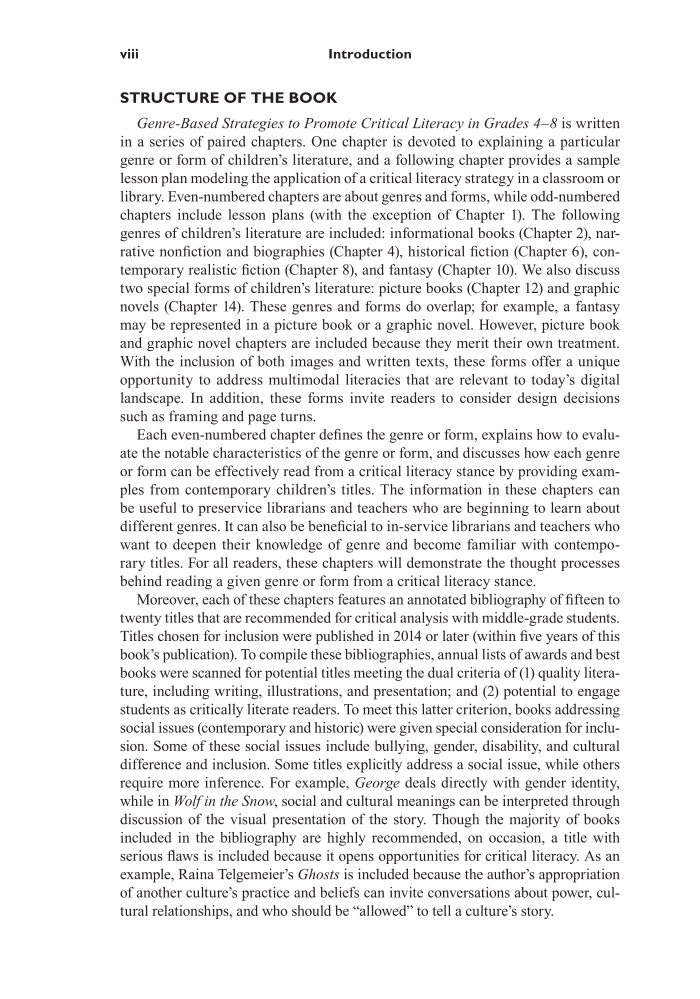viii Introduction STRUCTURE OF THE BOOK Genre-Based Strategies to Promote Critical Literacy in Grades 4–8 is written in a series of paired chapters. One chapter is devoted to explaining a particular genre or form of children’s literature, and a following chapter provides a sample lesson plan modeling the application of a critical literacy strategy in a classroom or library. Even-numbered chapters are about genres and forms, while odd-numbered chapters include lesson plans (with the exception of Chapter 1). The following genres of children’s literature are included: informational books (Chapter 2), nar- rative nonfiction and biographies (Chapter 4), historical fiction (Chapter 6), con- temporary realistic fiction (Chapter 8), and fantasy (Chapter 10). We also discuss two special forms of children’s literature: picture books (Chapter 12) and graphic novels (Chapter 14). These genres and forms do overlap for example, a fantasy may be represented in a picture book or a graphic novel. However, picture book and graphic novel chapters are included because they merit their own treatment. With the inclusion of both images and written texts, these forms offer a unique opportunity to address multimodal literacies that are relevant to today’s digital landscape. In addition, these forms invite readers to consider design decisions such as framing and page turns. Each even-numbered chapter defines the genre or form, explains how to evalu- ate the notable characteristics of the genre or form, and discusses how each genre or form can be effectively read from a critical literacy stance by providing exam- ples from contemporary children’s titles. The information in these chapters can be useful to preservice librarians and teachers who are beginning to learn about different genres. It can also be beneficial to in-service librarians and teachers who want to deepen their knowledge of genre and become familiar with contempo- rary titles. For all readers, these chapters will demonstrate the thought processes behind reading a given genre or form from a critical literacy stance. Moreover, each of these chapters features an annotated bibliography of fifteen to twenty titles that are recommended for critical analysis with middle-grade students. Titles chosen for inclusion were published in 2014 or later (within five years of this book’s publication). To compile these bibliographies, annual lists of awards and best books were scanned for potential titles meeting the dual criteria of (1) quality litera- ture, including writing, illustrations, and presentation and (2) potential to engage students as critically literate readers. To meet this latter criterion, books addressing social issues (contemporary and historic) were given special consideration for inclu- sion. Some of these social issues include bullying, gender, disability, and cultural difference and inclusion. Some titles explicitly address a social issue, while others require more inference. For example, George deals directly with gender identity, while in Wolf in the Snow, social and cultural meanings can be interpreted through discussion of the visual presentation of the story. Though the majority of books included in the bibliography are highly recommended, on occasion, a title with serious flaws is included because it opens opportunities for critical literacy. As an example, Raina Telgemeier’s Ghosts is included because the author’s appropriation of another culture’s practice and beliefs can invite conversations about power, cul- tural relationships, and who should be “allowed” to tell a culture’s story.
Document Details My Account Print multiple pages
Print
You have printed 0 times in the last 24 hours.
Your print count will reset on at .
You may print 0 more time(s) before then.
You may print a maximum of 0 pages at a time.




































































































































































